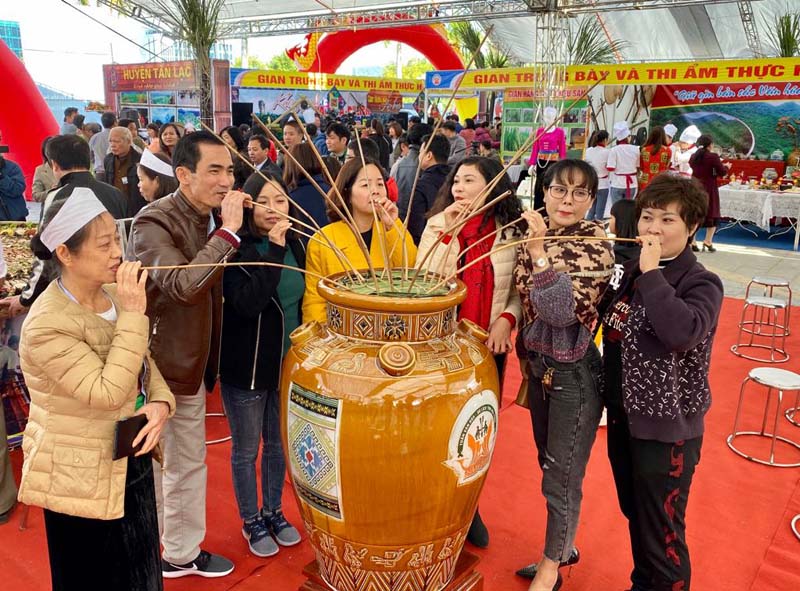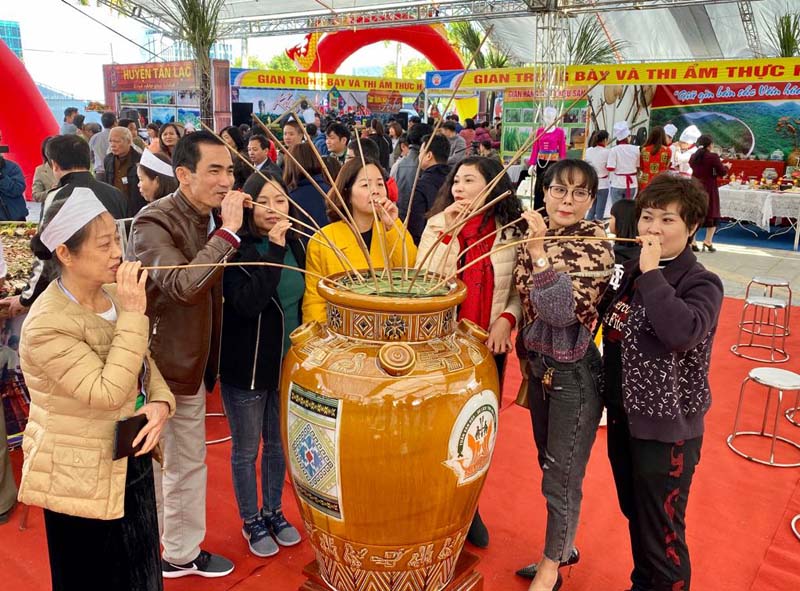
(HBO) - The special food tray on leaves, the most unique culinary flavor of Hoa Binh, the mountainous area, is considered to be a primitive culinary culture of Muong ethnic people.
The speciality of the food tray on leaves
To have a delicious special food tray on leaves, it is necessary to have the right material. The most popular material is the indigenous pig, also known as the hog badger, weighing 15 - 30 kg. This type of pig is often raised on the forest or semi-unbridled, eating vegetables, corn, cassava all year round so the meat is firm, low-fat with naturally sweet-smelling. The leaves used for food display are banana leaves taken from forests that have been exposed to fire and have a characteristic aromatic smell, symbolizing the attachment of the residents to the mountains.
 The visitors attending the Week of Culture and Tourism in Hoa Binh province in 2019 are enjoying the special Can wine made from yeast.
The visitors attending the Week of Culture and Tourism in Hoa Binh province in 2019 are enjoying the special Can wine made from yeast.
Now the special food trays on leaves are not only monotonous with only boiled dishes. They are very lively, sophisticated with eye-catching decoration and being added with the grilled dishes, rolls in pomelo leaves and the additional dishes such as Loong soup. The aromatic white sticky rice is wrapped square in banana leaves, symbolizing the quintessence of the land and the forest. Accompanied with the food is the salt with the seed from michelia tonkinensis. The grilled seeds from michelia tonkinensis are mixed with roasted salt have become an indispensable part of Muong special food tray, making it more charming.
The famous specialty, Can wine
It is said in the legend that Can wine of Muong ethnic people was born from the skillful hands, wisdom and virtue of Muong girls. Drinking Can wine of Muong ethnic people means drinking the natural milk from the mother and drinking the warm love of people.
Today's Can wine is widely used in the activities of the community, celebrating new houses, wedding parties, receptions or religious ceremonies. Especially, it has become a gift bringing a warm and happy feeling to every happy event. Can wine has become a brand of origin in Hoa Binh, appearing a number of establishments and villages producing Can wine to serve customers’ need of enjoyment all over the country.
In addition to the special food tray on leaves, the jar of Can wine is the most unique cuisine of Muong area, other culinary flavors of Muong ethnic people in Hoa Binh are also praised by the customers, such as boiled vegetables made from the leaves of Carica papaya, Meo broccoli, wild betel leaves, broccoli or pickled bamboo shoots cooked with chicken, buffalo with persicaria chinensis ... Coming to Muong area in Hoa Binh, enjoying the special food tray of Muong, enjoying drunk in yeast of Can wine on the occasions of festivals or New Year, you can feel all the meaning, unique cuisine flavor in the life of Muong ethnic people.
With an increasingly vibrant and widespread emulation movement aimed at building cultured residential areas and cultured families, Yen Thuy District has been making steady progress toward improving both the material and spiritual well-being of its people, while fostering a civilized, prosperous, beautiful, and progressive community.
Once lacking recreational spaces and community facilities, Residential Group 2 in Quynh Lam Ward (Hoa Binh City) has recently received attention for the construction of a new, spacious, and fully equipped cultural house. The project followed the model of state support combined with public contributions in both labor and funding.
The "All people unite to build cultural life" movement, which has been effectively integrated with Kim Boi district’s socio-economic development goals, is fostering a lively spirit of emulation across local residential areas, hamlets, villages, public agencies, and enterprises. In addition, through the initiative, traditional cultural values are being preserved and promoted, while community solidarity and mutual support in poverty reduction and economic development are being strengthened.
A working delegation of the Hoa Binh provincial People’s Committee led by its Permanent Vice Chairman Nguyen Van Toan on June 11 inspected the progress of a project to build the Mo Muong Cultural Heritage Conservation Space linked to tourism services in Hop Phong commune, Cao Phong district.
Born and growing in the heroic land of Muong Dong, Dinh Thi Kieu Dung, a resident in Bo town of Kim Boi district, in her childhood was nurtured by the sweet lullabies of her grandmother and mother. These melodies deeply imprinted on her soul, becoming an inseparable part of her love for her ethnic group's culture. For over 20 years, this love for her hometown has driven Dung to research, collect, and pass down the cultural values of the Muong people to future generations.
In the final days of May, the Ethnic Art Troupe of Hoa Binh Province organized performances to serve the people in remote, mountainous, and particularly disadvantaged areas within the province. These were not just ordinary artistic shows, but they were the meaningful journeys aimed at spreading cultural values, enhancing the spiritual life of the people and contributing to the preservation of ethnic minority cultural identities.



 The visitors attending the Week of Culture and Tourism in Hoa Binh province in 2019 are enjoying the special Can wine made from yeast.
The visitors attending the Week of Culture and Tourism in Hoa Binh province in 2019 are enjoying the special Can wine made from yeast.